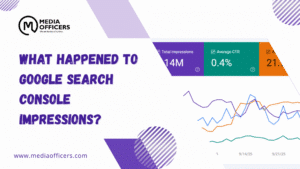Google Search Console impressions have shifted in 2025, and understanding why this happened is essential for accurate SEO reporting. The change isn’t about ranking positions or SERP quality; it’s about how Google reports visibility to webmasters. In this guide, we unpack what changed, why it happened, and how to adapt dashboards and models to the new baseline for genuine measurement.
What happened to Google Search Console impressions?
The drop traces back to Google’s quiet decision to stop supporting the &num=100 parameter, which previously allowed tools and crawlers to fetch up to 100 results per query. With that capability removed, the extra data points vanished overnight. The search results themselves didn’t change; what changed was the visibility reporting itself. Third‑party platforms lost signal beyond the top 20 results, and Google Search Console recalibrated to reflect real user activity instead of automated crawler noise. This isn’t a ranking shock, but a reporting shift that alters how we interpret visibility data.
Why this change makes sense
As many SEOs and site owners have observed, we need to reset how we interpret impressions: treat the data you see now as the new normal. Discontinuing support for the &num=100 parameter makes sense; fewer results per query reduces noise and aligns reporting with what users actually see. The garage sale analogy is apt: fewer choices often lead to clearer signals and better decisions. The change also makes practical sense for Google, because delivering 10–20 results per query is more reliable and less resource-intensive than generating a full 100. Importantly, this shift didn’t change real user behavior or the SERP itself; it changed how we measure and report visibility.
The alligator effect and the September shift
Earlier in the year, we observed the so‑called alligator effect in GSC charts impressions rising while clicks remained steady, creating an open‑mouth shape. Many attributed that to AI‑driven overviews and a growing wave of zero‑click experiences. On September 12, the policy change removing the &num=100 parameter effectively closed the mouth. Impressions dropped back toward pre‑AI baselines, and the data began to reflect real user activity more accurately. Some observers speculate that a portion of prior impressions may have originated from automated scraping or exposure in large language models, rather than direct live SERP visibility. While unconfirmed, this distinction helps explain why the post‑change data feels more trustworthy for ongoing optimization.
What this means for reporting
Despite fluctuations, Google Search Console remains the most reliable source for keyword ranking data, especially now that third‑party tools no longer capture results beyond Positions 1–20. For most reporting contexts, annotate the measurement change and use the current impression and average position levels as your new baseline. This creates a consistent frame of reference across dashboards, dashboards, and executive reports.
Suggested annotation: The data reported in Google Search Console (GSC) from 9/13/2025 onwards is the most accurate accounting of how your brand appears in Google organic search. GSC stopped supporting the &num=100 parameter around 9/12/2025, resulting in impressions generated by third‑parties and automated crawlers being removed from reporting.
If impressions or average position are used in broader models or long‑term trend analyses, adjustments between Feb. 1 and Sept. 12, 2025, may be appropriate.
Option 1: Simple method
Use prior‑year impressions and average position up to the start of volatility in early February. When impressions began to rise sharply (Feb 1–Sept 12, 2025), revert to prior‑year values, then use GSC data as reported from Sept 13 onward.
Option 2: Advanced method
Rebuild historical impressions and average position using trend data and adjustment factors. Evaluate differences in fluctuation by query type or ranking position (branded, non‑branded, long‑tail). Consider metrics such as GSC clicks, which were less correlated with impressions during the affected period, and adjust for other factors unaffected by impression volatility.
What to expect from GSC going forward
Treat the post‑change figures as the new baseline. The numbers you see now reflect how GSC will report visibility from here on. Impressions will stabilize at lower levels compared with earlier 2025 trends. Average position will level out since it’s calculated relative to impressions. The number of unique queries reported in Positions 1–20 will hold steady, and there will be fewer long‑tail signals in those top positions. Clicks and traffic should remain consistent, confirming that user engagement with your listings hasn’t changed.
Why impressions and average position still matter
Even with the recalibration, impressions and average position remain key indicators of visibility and progress just measured more accurately. Consistency: these metrics now reflect real search activity rather than automated crawler noise. Visibility tracking: they’re still useful for identifying when optimizations begin to take effect. Stability: data for keywords ranking in the top 20 positions show steadier trends than long‑tail terms, since older data beyond 20 results is no longer captured.
A clearer baseline for visibility
The current impression and average position levels offer a clearer baseline for reporting. If you use impressions or average position in models or performance controls, normalization methods can help harmonize historical data. In most cases, though, it’s best to move forward with the current figures as the baseline for future reporting. Google simply made fewer results available, but searchers still find what they’re looking for, and third‑party tools will adapt.
Step-by-step SEO strategy to execute
Adapting to the post‑change reality requires a deliberate strategy. Below is a practical, findings‑driven plan you can implement now.
- Analyze Search Intent & Keywords: Determine the primary search intent behind the topic. Identify a clear primary target keyword and 3–4 related secondary keywords (LSI) to support the topic. For this article, the primary focus keyword is Google Search Console impressions, with related terms like &num=100 parameter, alligator effect, Positions 1–20, and long‑tail queries.
- Craft Core SEO Elements: Create an SEO title that places the focus keyword first, uses a power word and a sentiment word, includes a number if possible, and stays under 65 characters. Write a meta description of 150–160 characters that compels clicks and includes the focus keyword.
- Construct the Article Content: Use clear headings (H2 and H3), short paragraphs, and bold key terms. Include bullets and lists to improve skimmability. Weave both the focus keyword and LSIs naturally into headings and body text.
- Publish with On‑Page Signals: Ensure the article loads quickly, uses accessible header structure, and includes internal links to related content such as historical reporting methods and new baseline concepts.
- Measure & Iterate: After publication, monitor how the page ranks for your focus keyword and related terms. Update the content as needed to preserve a strong SEO signal over time.
Frequently Asked Questions
Why did Google Search Console impressions drop?
It primarily reflects a reporting change after Google stopped supporting the &num=100 parameter, not a sudden shift in SERP rankings.
Will this change hurt my SEO rankings?
No. The drop is in reporting; rankings themselves are determined by page quality and signals, not by the GSC data feed.
How should I annotate my dashboards?
Use a clear note stating that from 9/13/2025, GSC reports reflect a new baseline for visibility, with references to the &num=100 parameter removal.
Should I revert to pre‑February values?
You can use a simple or advanced method to adjust historical data, but moving forward with the new baseline is recommended.
Conclusion
Embracing the new baseline for Google Search Console impressions gives you a more accurate view of how users actually encounter your brand in search. The change reduces noise, clarifies signal, and provides a stable foundation for future optimization. By annotating the shift, adjusting models, and focusing on the top‑20 visibility, you can maintain strong SEO performance without chasing misleading impressions from automated data. This recalibration isn’t a setback; it’s a clearer, more trustworthy lens on real user behavior in 2025 and beyond.





